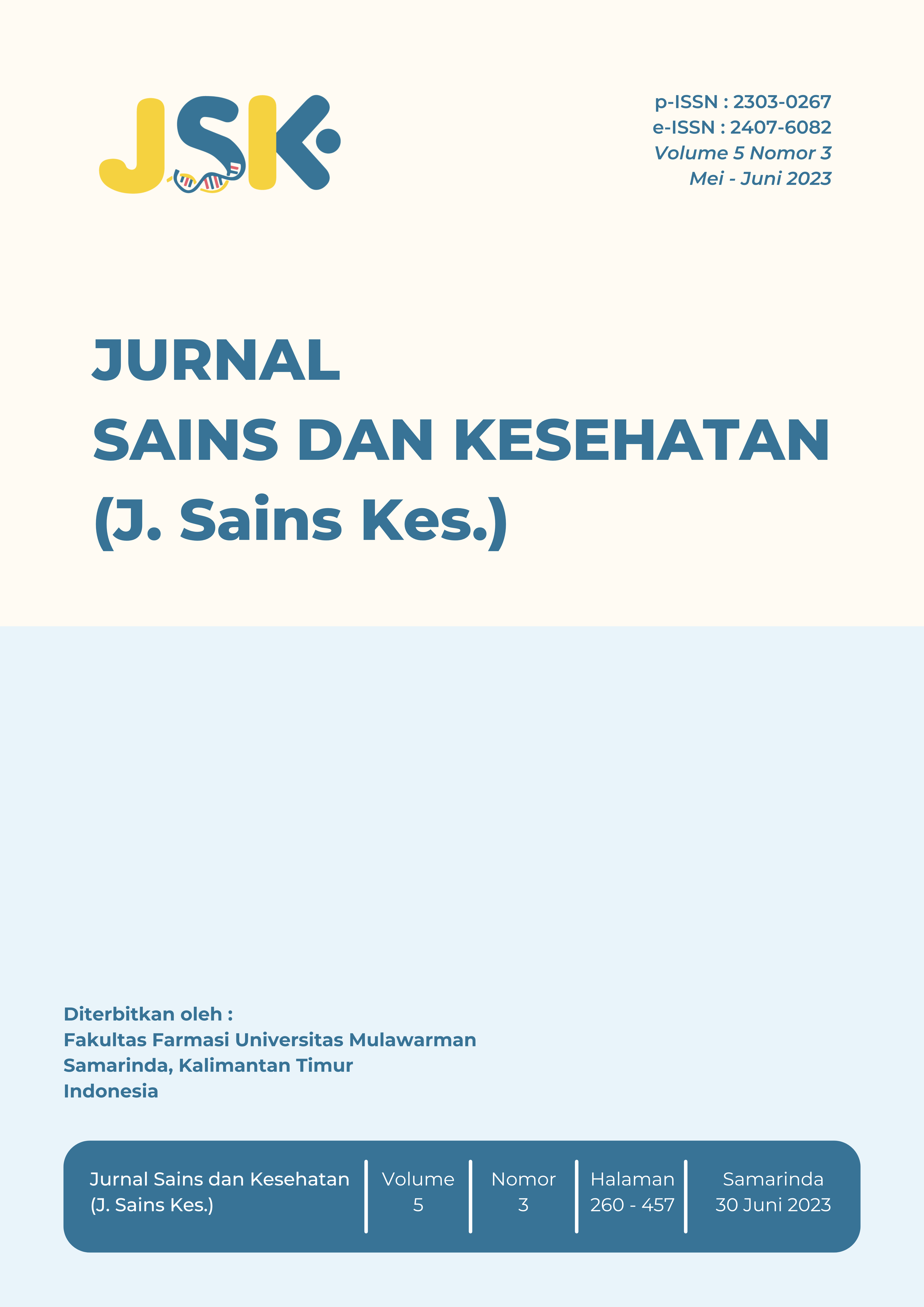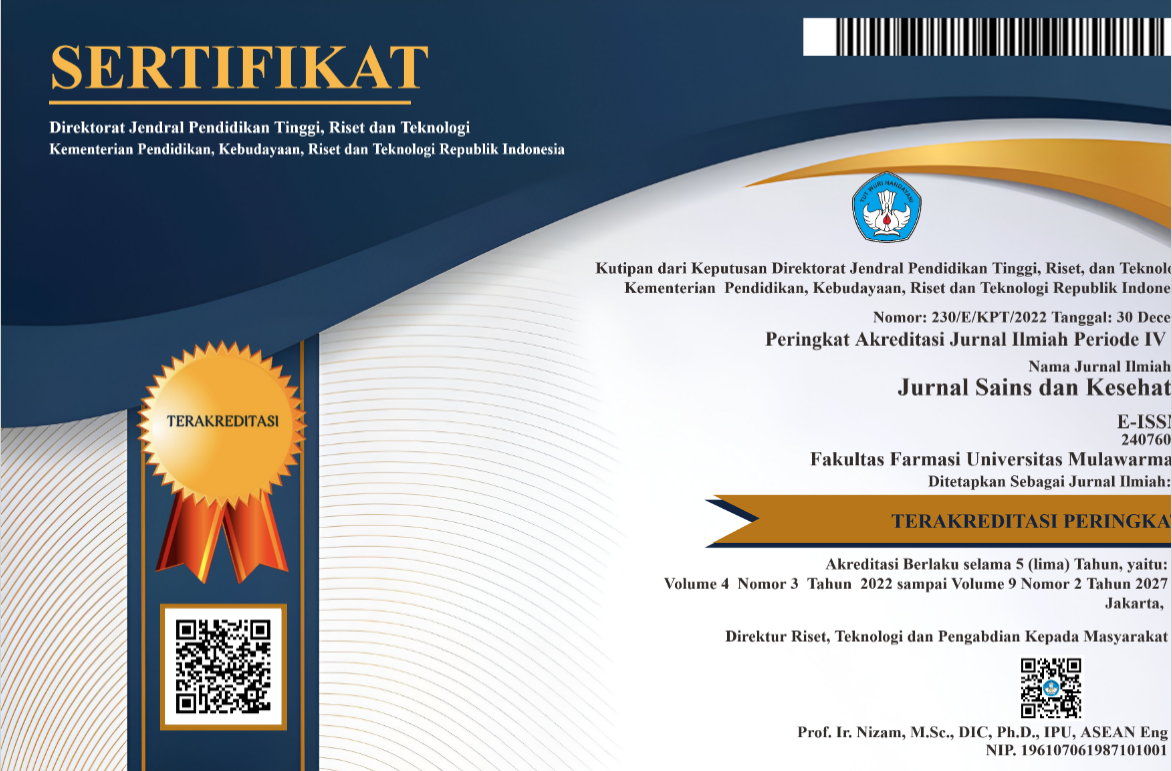Hand Sanitizer Ekstrak Etanol Daun Simpur (Dillenia suffruticosa) sebagai Antiseptik Bakteri Escherechia coli dan Staphilococcus aureus
Keywords:
Dillenia suffruticosa, Hand sanitizer, Ekstrak etanol, Escherichia coli, Staphylococcus aureusAbstract
References
C. J. . Lopez, A.D., Mathers, C.D., Ezzati, M. , Jamison, D.T., Murray, Global burden of disease and risk factors. New York: Oxford University Press, 2006.
R. . Kim-Farley, Global strategies for control of communicable diseases. In: Detels R, McEwen J, Beaglehole R, Tanaka H (eds) Oxford textbook of public health. Oxford, 2004.
E. Folch, “Infectious diseases, non-zero-sum thinking, and the developing world,” Am J Med Sci, vol. 326, pp. 66–72, 2003.
W. H. O. WHO, “Global Report on Diabetes France,” 2022.
P. A. Potter and A. G. Perry, “Buku ajar fundamental keperawatan: konsep, proses, dan praktik,” Jakarta EGC, 2005.
M. P. Hati et al., “Edukasi Pentingnya Mencuci Tangan Dengan Sabun Di Era New Normal,” SELAPARANG J. Pengabdi. Masy. Berkemajuan, vol. 5, no. 1, 2021, doi: 10.31764/jpmb.v5i1.6201.
S. P. Luby, M. Aeboatwalla, A. Bowen, E. Kenah, Y. Sharker, and R. M. Hoekstra, “Difficulties in maintaining improved handwashing behavior, Karachi, Pakistan,” Am. J. Trop. Med. Hyg., vol. 81, no. 1, 2009, doi: 10.4269/ajtmh.2009.81.140.
M. Burton, E. Cobb, P. Donachie, G. Judah, V. Curtis, and W. P. Schmidt, “The effect of handwashing with water or soap on bacterial contamination of hands,” Int. J. Environ. Res. Public Health, vol. 8, no. 1, 2011, doi: 10.3390/ijerph8010097.
I. S. dkk Mustikawati, “Hubungan antara Pengetahuan mengenai Perilaku Cuci Tangan Pakai Sabun dengan Perilaku Cuci Tangan Pakai Sabun pada Ibu-ibu di Kampung Nelayan Muara Angke, Jakarta Utara,” Forum Ilm., vol. 13, no. 2, 2016.
Wijayanto, Kurniawan, and Sobri, “Formulasi dan Efektivitas Gel Antiseptik Tangan Minyak Atsiri Lengkuas (Alpinia galanga (L.) Willd.),” J. Ilmu Kefarmasian Indones., vol. 11, no. 2, 2013.
J. . Bate-Smith, E.C., Harborne, “Differences in flavonoid content between freshand herbarium leaf tissue in Dillenia,” Phytochem, vol. 10, pp. 1055–1058, 1971.
R. Foo, J.B., Yazan, L.S., Tor, Y.S., Wibowo, A., Ismail, N., How, C.W., Armania, N., Loh, S.P., Ismail, I.S., Cheah, Y.K., Abdullah, “Induction of cell cycle arrest and apoptosis by betulinic acid-rich fraction from Dillenia suffruticosa root in MCF-7cells involved p53/p21 and mitochondrial signaling pathway,” J. Ethnopharmacol, vol. 166, pp. 270–278, 2015.
C. Wiart, “Antimicrobial screening of plants used for traditionalmedicine in the state of Perak, Peninsular Malaysia,” Fitoterapia, vol. 75, pp. 68–73, 2004.
C. Zongo, A. Savadogo, M. K. Somda, J. Koudou, and A. S. Traore, “In vitro evaluation of the antimicrobial and antioxidant properties of extracts from whole plant of Alternanthera pungens H.B. & K. and leaves of Combretum sericeum G. Don,” Int. J. Phytomedicine, vol. 3, no. 2, 2011.
H. M. Darsana, I.G.O., I.N.K. Besung, “Potensi Daun Binahong (Anredera cordifolia (Tenore) Steenis) dalam Menghambat Pertumbuhan Bakteri Escherichia coli secara In Vitro,” Indones. Med.Vet, vol. 1(3), pp. 337–351, 2012.
A. S. Parubak, “Senyawa Flavonoid Yang Bersifat Antibakteri Dari Akway,” J. Kim. Univ. Sam Ratulangi, vol. 6, no. 1, 2013.
T. S. Utami, R. Arbianti, H. Hermansyah, and A. Reza, “Perbandingan Aktivitas Antioksidan Ekstrak Etanol Daun Simpur (Dillenia indica) dari Berbagai Metode Ekstraksi dengan Uji ANOVA,” Seminar Nasional Teknik Kimia Indonesia-SNTKI, 2009.
M. Apu, A.S., Muhit, M.A., Tareq, S.M., Pathan, A.H., Jamaluddin, A.T.M., Ahmed, “Antimicrobial activity and brine shrimp lethality bioassay of the leavesextract of Dillenia indica Linn. J,” Young Pharm, vol. 2(1), pp. 50–53, 2010.
A. Garg, D. Aggarwal, S. Garg, and A. K. Singla, “Spreading of semisolid formulations: An update,” Pharmaceutical Technology North America, vol. 26, no. 9. 2002.
A. Torres et al., “Structure elucidation and NMR assignments of two unusual monoterpene indole alkaloids from Psychotria stachyoides,” Magn. Reson. Chem., vol. 48, no. 9, 2010, doi: 10.1002/mrc.2656.
A. Cushnie, T.P.T, Lamb, “Review: Antimicrobial activity of flavanoids,” Int. J.Antimicro. Agents, vol. 26, pp. 343–356, 2005.
R. Arbianti, “Perbandingan Aktivitas Antioksidan Ekstrak Etanol Daun Simpu (Dillenia indica) dari Berbagai Metode Ekstraksi dengan Uji Anova,” Jurnal Seminar Nasional Teknik Kimia Industri-SNTKI, 2009. staff.ui.ac.id/system/files/users/tania.surya/publication/perbandinganaktivitas.pdf, (accessed Nov. 04, 2017).
H. T. and Z. Z. Pan, X., F. Chen, T. Wu, “The Acid, Bile Tolerance and Antimicrobial Property of Lactobacillus acidophilus NIT,” J. Food Control, vol. 20, pp. 598–602, 2009.
S. N. Indonesia, Deterjen Sintetik Cair Pembersih Tangan. Badan Standarisasi Nasional. Standar Nasional Indonesia., 1992.
J. B. dan R. J. M. Wilkinson, Harry’s Cosmeticology Seventh Edition. New York: Chemical Publishing, 1982.
M. Shu, “Formulasi Sediaan Gel Hand Sanitizer Dengan Bahan Aktif Triklosan 0,5% Dan 1% Melisa,” J. Ilm. Mhs. Univ. Surabaya, vol. 2, no. 1, 2013.
D. P. Astuti, P. Husni, and K. Hartono, “Formulasi Dan Uji Stabilitas Fisik Sediaan Gel Antiseptik Tangan Minyak Atsiri Bunga Lavender (Lavandula angustifolia Miller),” Farmaka, vol. 15, no. 1, 2017.
Downloads
Published
Issue
Section
Deprecated: json_decode(): Passing null to parameter #1 ($json) of type string is deprecated in /home/jskff/public_html/plugins/generic/citations/CitationsPlugin.php on line 68
How to Cite
Similar Articles
- Rizka Ahyar Hidayati, Ary Kristijono, Afidatul Muadifah, Uji Aktivitas Antibakteri Sediaan Gel Hand Sanitizer Ekstrak Kulit Buah Jengkol(Archidendron pauciflorum (Benth.) Nielsen) terhadap Bakteri Escherichia coli , Jurnal Sains dan Kesehatan: Vol. 3 No. 2 (2021): J. Sains Kes.
- Asrianto Asrianto, Asrori Asrori, Indra Taufik Sahli, Risda Hartati, Fajar Bakti Kurniawan, Rina Purwati, Bioaktivitas Ekstrak Etanol Biji Pinang (Arecha catechu L.) terhadap Staphylococcus aureus dan Escherichia coli , Jurnal Sains dan Kesehatan: Vol. 3 No. 6 (2021): J. Sains Kes.
- Muh. Nasir, Eri Marwati, Uji Aktivitas Antimikroba Ekstrak Etanol Daging Buah dan Daun Pala (Myristica fragrans) , Jurnal Sains dan Kesehatan: Vol. 4 No. SE-1 (2022): Spesial Edition J. Sains Kes.
- Asti Vebriyanti Asjur, Karakterisasi Fungi Endofit Syzygium polyanthum (Wight) Walp. Berdasarkan Gen ITS Sebagai Penghasil Senyawa Antibakteri , Jurnal Sains dan Kesehatan: Vol. 3 No. 3 (2021): J. Sains Kes.
- Nurhidayati Febriana, Fajar Prasetya, Arsyik Ibrahim, Aktivitas Antimikroba Ekstrak Daun Bungur (Langerstroemia speciosa (L.) Pers) , Jurnal Sains dan Kesehatan: Vol. 1 No. 2 (2015): J. Sains Kes.
- Sri Mulyaningsih, Agustriyanata Vieri Ansharullah, Potensi Ekstrak Lengkuas Merah (Alpinia purpurata K. Schum) sebagai Cairan Pencuci Buah , Jurnal Sains dan Kesehatan: Vol. 4 No. SE-1 (2022): Spesial Edition J. Sains Kes.
- Jessie Elviasari, Rolan Rusli, Adam M. Ramadhan, Identifikasi Metabolit Sekunder Dan Uji Aktivitas Antibakteri Isolat Jamur Endofit Daun Beluntas (Pluchea indica (L.) Less.) , Jurnal Sains dan Kesehatan: Vol. 1 No. 5 (2016): J. Sains Kes.
- Lisna Meylina, Arsyik Ibrahim, Laode Rijai, Kajian Konsentrasi Ekstrak Daun Sirih Merah (Piper crocatum) sebagai Bahan Aktif Antiseptik dalam Sediaan Sabun Padat , Jurnal Sains dan Kesehatan: Vol. 3 No. 6 (2021): J. Sains Kes.
- Eko Kusumawati, Anita Apriliana, Rahmi Yulia , Kemampuan Antibakteri Ekstrak Etanol Daun Nangka (Atrocarpus heterophyllus Lam.) terhadap Escherichia coli , Jurnal Sains dan Kesehatan: Vol. 1 No. 7 (2017): J. Sains Kes.
- Shindy Charisma Nur Qur'an, Choirul Huda, Rahma Diyan Martha, Uji Aktivitas Antibakteri Fraksi Daun Eceng Gondok (Eichhornia crassipes) terhadap Bakteri Staphylococcus aureus , Jurnal Sains dan Kesehatan: Vol. 3 No. 2 (2021): J. Sains Kes.
You may also start an advanced similarity search for this article.




